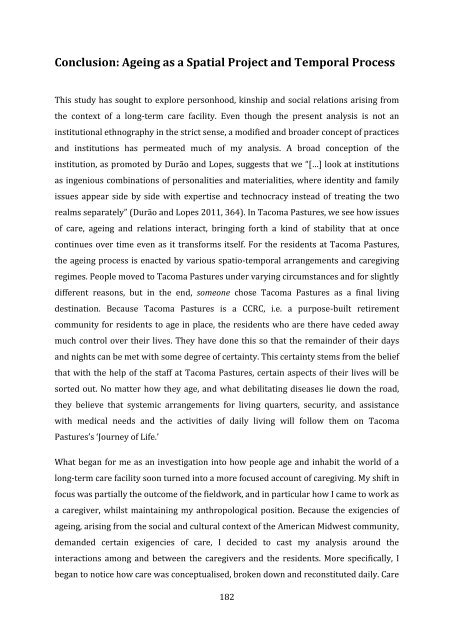Philip Y. Kao PhD thesis - Research@StAndrews:FullText
Philip Y. Kao PhD thesis - Research@StAndrews:FullText
Philip Y. Kao PhD thesis - Research@StAndrews:FullText
You also want an ePaper? Increase the reach of your titles
YUMPU automatically turns print PDFs into web optimized ePapers that Google loves.
Conclusion: Ageing as a Spatial Project and Temporal Process<br />
This study has sought to explore personhood, kinship and social relations arising from<br />
the context of a long-term care facility. Even though the present analysis is not an<br />
institutional ethnography in the strict sense, a modified and broader concept of practices<br />
and institutions has permeated much of my analysis. A broad conception of the<br />
institution, as promoted by Durão and Lopes, suggests that we “[…] look at institutions<br />
as ingenious combinations of personalities and materialities, where identity and family<br />
issues appear side by side with expertise and technocracy instead of treating the two<br />
realms separately” (Durão and Lopes 2011, 364). In Tacoma Pastures, we see how issues<br />
of care, ageing and relations interact, bringing forth a kind of stability that at once<br />
continues over time even as it transforms itself. For the residents at Tacoma Pastures,<br />
the ageing process is enacted by various spatio-temporal arrangements and caregiving<br />
regimes. People moved to Tacoma Pastures under varying circumstances and for slightly<br />
different reasons, but in the end, someone chose Tacoma Pastures as a final living<br />
destination. Because Tacoma Pastures is a CCRC, i.e. a purpose-built retirement<br />
community for residents to age in place, the residents who are there have ceded away<br />
much control over their lives. They have done this so that the remainder of their days<br />
and nights can be met with some degree of certainty. This certainty stems from the belief<br />
that with the help of the staff at Tacoma Pastures, certain aspects of their lives will be<br />
sorted out. No matter how they age, and what debilitating diseases lie down the road,<br />
they believe that systemic arrangements for living quarters, security, and assistance<br />
with medical needs and the activities of daily living will follow them on Tacoma<br />
Pastures’s ‘Journey of Life.’<br />
What began for me as an investigation into how people age and inhabit the world of a<br />
long-term care facility soon turned into a more focused account of caregiving. My shift in<br />
focus was partially the outcome of the fieldwork, and in particular how I came to work as<br />
a caregiver, whilst maintaining my anthropological position. Because the exigencies of<br />
ageing, arising from the social and cultural context of the American Midwest community,<br />
demanded certain exigencies of care, I decided to cast my analysis around the<br />
interactions among and between the caregivers and the residents. More specifically, I<br />
began to notice how care was conceptualised, broken down and reconstituted daily. Care<br />
182
















